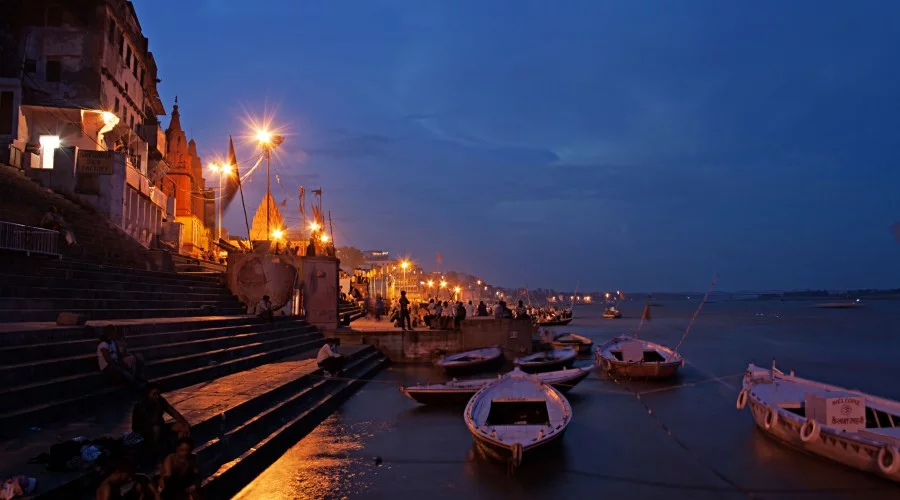Vibrant Varanasi: Unveiling India’s Spiritual Heart
Varanasi, also known as Kashi or Banaras, is a city located on the banks of the sacred Ganges River in the northern state of Uttar Pradesh, India. It is considered one of the oldest continuously inhabited cities in the world and holds immense spiritual significance for Hindus. Varanasi is renowned for its vibrant and colorful atmosphere, rich cultural heritage, and deep-rooted religious traditions. As the spiritual heart of India, it attracts millions of pilgrims and tourists each year who come to witness its sacred rituals, explore its ancient temples, and experience the unique blend of spirituality and chaos that defines this enchanting city.
Exploring the Ghats of Varanasi: A Spiritual Journey along the Sacred Ganges River
Varanasi, also known as Kashi, is a city that holds immense spiritual significance in India. Situated on the banks of the sacred Ganges River, it is considered the spiritual heart of the country. The city is a vibrant tapestry of ancient traditions, rituals, and beliefs that have been passed down through generations. Exploring the ghats of Varanasi is a spiritual journey like no other, offering a glimpse into the rich cultural heritage and deep-rooted spirituality of India.
The ghats of Varanasi are a series of steps leading down to the river, each with its own unique identity and purpose. There are over 80 ghats in total, each serving a specific function, be it bathing, cremation, or religious ceremonies. The most famous and revered ghat is the Dashashwamedh Ghat, where the Ganga Aarti, a mesmerizing ritual of worship, takes place every evening. Devotees gather here to witness the spectacle of priests offering prayers to the river, accompanied by the rhythmic chants and the sound of bells. It is a truly awe-inspiring experience that leaves a lasting impression on all who witness it.
As you stroll along the ghats, you will encounter Sadhus, or holy men, who have renounced worldly possessions in pursuit of spiritual enlightenment. These ascetics, with their long matted hair and ash-smeared bodies, are a common sight in Varanasi. They meditate, perform rituals, and offer blessings to those seeking spiritual guidance. Engaging in a conversation with a Sadhu can be a profound experience, as they share their wisdom and insights into the mysteries of life.
One of the most sacred ghats in Varanasi is the Manikarnika Ghat, where cremations take place round the clock. Hindus believe that being cremated here ensures liberation from the cycle of birth and death. Witnessing a cremation ceremony can be a deeply moving experience, as it confronts the impermanence of life and the inevitability of death. It is a reminder of the transient nature of our existence and the need to live each moment with mindfulness and gratitude.
The ghats of Varanasi are not just places of religious significance; they are also centers of learning and culture. The Banaras Hindu University, one of the oldest and most prestigious educational institutions in India, is located near the Assi Ghat. The university attracts scholars and students from all over the world, contributing to the intellectual vibrancy of the city. The ghats also serve as a platform for various cultural activities, such as music and dance performances, which showcase the rich artistic heritage of Varanasi.
Exploring the ghats of Varanasi is not just a visual and sensory experience; it is a journey of the soul. The spiritual energy that permeates the air is palpable, and it has the power to transform and uplift those who are open to its influence. It is a place where one can connect with the divine, find solace in the midst of chaos, and gain a deeper understanding of the mysteries of life.
In conclusion, the ghats of Varanasi offer a unique and profound spiritual journey along the sacred Ganges River. From witnessing the mesmerizing Ganga Aarti at Dashashwamedh Ghat to engaging in conversations with Sadhus, from witnessing cremation ceremonies at Manikarnika Ghat to immersing oneself in the intellectual and cultural vibrancy of the city, Varanasi is a place that leaves an indelible mark on the hearts and minds of all who visit. It is a testament to the enduring power of spirituality and the rich cultural heritage of India.
Unveiling the Mystical Charms of Varanasi: Temples, Rituals, and Sacred Traditions
Varanasi, also known as Kashi or Benares, is a city that holds immense spiritual significance in India. Situated on the banks of the sacred Ganges River, it is considered the spiritual heart of the country. Varanasi is a place where ancient traditions, rituals, and temples come together to create a mystical and vibrant atmosphere that captivates visitors from around the world.
One of the most enchanting aspects of Varanasi is its numerous temples. The city is home to over 2,000 temples, each with its own unique architectural style and religious significance. The Kashi Vishwanath Temple, dedicated to Lord Shiva, is one of the most revered temples in Varanasi. Its golden spire and intricate carvings attract devotees and tourists alike. Another notable temple is the Sankat Mochan Hanuman Temple, dedicated to Lord Hanuman, the monkey god. This temple is believed to fulfill the wishes of its devotees and is always bustling with activity.
Rituals play a vital role in the daily life of Varanasi. The Ganga Aarti, a mesmerizing ceremony performed every evening on the banks of the Ganges, is a sight to behold. Devotees gather to witness the priests offering prayers, chanting mantras, and waving oil lamps in a synchronized manner. The atmosphere is filled with devotion and spirituality as the river becomes illuminated by the flickering flames. It is believed that attending the Ganga Aarti washes away one’s sins and brings blessings.
Another significant ritual in Varanasi is the performance of last rites at the cremation ghats. The Manikarnika Ghat and Harishchandra Ghat are the two main cremation sites where bodies are cremated in accordance with Hindu customs. Witnessing these rituals can be a profound and humbling experience, as it reminds us of the impermanence of life and the cycle of death and rebirth.
Varanasi is also known for its sacred traditions. The city has been a center for learning and spirituality for centuries. The Banaras Hindu University, founded in 1916, is one of the oldest and most prestigious educational institutions in India. It offers courses in various disciplines and attracts students from all over the country. The city is also famous for its silk weaving industry, with Varanasi silk sarees being highly sought after for their intricate designs and craftsmanship.
Exploring the narrow lanes and alleys of Varanasi is like stepping back in time. The old city, known as the Kashi Vishwanath corridor, is a maze of ancient buildings, bustling markets, and hidden gems. The vibrant colors, aromatic spices, and the constant hum of activity create an atmosphere that is both chaotic and captivating. It is in these narrow lanes that one can truly experience the essence of Varanasi and its rich cultural heritage.
In conclusion, Varanasi is a city that offers a unique and immersive experience for those seeking spiritual enlightenment. Its temples, rituals, and sacred traditions provide a glimpse into the deep-rooted spirituality that is an integral part of Indian culture. Whether it is witnessing the Ganga Aarti, exploring the ancient temples, or simply getting lost in the labyrinthine lanes, Varanasi is a place that leaves a lasting impression on all who visit. It is a city that truly embodies the mystical charms of India.
Varanasi’s Cultural Kaleidoscope: Music, Dance, and Art in the Vibrant City
Varanasi, also known as Benares or Kashi, is a city that pulsates with spirituality and culture. Located on the banks of the sacred Ganges River in the northern state of Uttar Pradesh, Varanasi is considered the spiritual heart of India. It is a city that has attracted pilgrims, artists, and scholars for centuries, and its cultural kaleidoscope is a testament to its rich heritage.
One of the most captivating aspects of Varanasi’s cultural scene is its music. The city has a long-standing tradition of classical music, with renowned musicians and music schools that have produced some of the finest talents in the country. The sounds of sitar, tabla, and sarod fill the air as musicians gather in temples, music academies, and even on the ghats (steps leading to the river) to perform soul-stirring ragas. The annual Sankat Mochan Music Festival, held in the famous Sankat Mochan Temple, attracts music lovers from all over the world who come to witness the mesmerizing performances by maestros of Indian classical music.
Dance is another integral part of Varanasi’s cultural fabric. The city is known for its unique dance form called Kathak, which originated in the courts of the Mughal emperors. Kathak is a blend of storytelling, rhythmic footwork, and graceful movements that captivate the audience. The famous Kathak Kendra, a national institute for Kathak dance, is located in Varanasi and offers training to aspiring dancers. The city also hosts the annual Ganga Mahotsav, a festival that showcases various dance forms from different parts of India, including Kathak, Bharatanatyam, and Odissi. The performances take place against the backdrop of the illuminated ghats, creating a magical ambiance that leaves spectators spellbound.
Art is another vibrant aspect of Varanasi’s cultural scene. The city has been a hub for artists and artisans for centuries, and its narrow lanes are lined with shops selling exquisite handicrafts, paintings, and sculptures. The famous Banarasi silk sarees, known for their intricate designs and vibrant colors, are a testament to the city’s rich textile heritage. The art of silk weaving has been passed down through generations, and the weavers continue to create masterpieces that are sought after by people from all over the world. The city is also home to numerous art galleries that showcase the works of local artists, providing a platform for them to showcase their talent.
In addition to music, dance, and art, Varanasi is also known for its religious festivals. The city celebrates numerous festivals throughout the year, with each one adding to its cultural vibrancy. The most famous of these is the festival of Diwali, also known as the Festival of Lights. During Diwali, the entire city is illuminated with thousands of oil lamps, creating a breathtaking sight. The ghats come alive with fireworks, music, and dance performances, and the atmosphere is filled with joy and celebration.
Varanasi’s cultural kaleidoscope is a testament to the city’s rich heritage and its ability to preserve and promote its traditions. Whether it is the soul-stirring music, the graceful dance performances, the exquisite art, or the vibrant festivals, Varanasi offers a sensory experience like no other. It is a city that continues to inspire and captivate, drawing people from all over the world to witness its cultural extravaganza.In conclusion, Vibrant Varanasi offers a unique and captivating experience, allowing visitors to witness the spiritual heart of India. With its rich history, sacred sites, and vibrant cultural traditions, Varanasi provides a deep insight into the spiritual and religious practices of the country. From the mesmerizing Ganga Aarti ceremony to the ancient temples and ghats along the Ganges River, Varanasi immerses travelers in a spiritual journey unlike any other. The city’s bustling markets, narrow lanes, and diverse cuisine further add to its charm. Vibrant Varanasi truly showcases the essence of India’s spiritual heritage and is a must-visit destination for those seeking a profound cultural experience.




